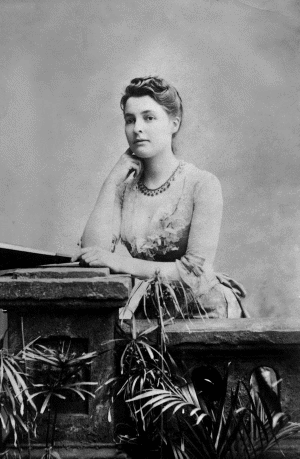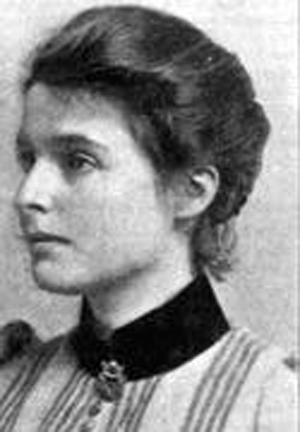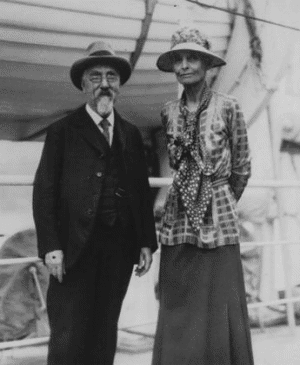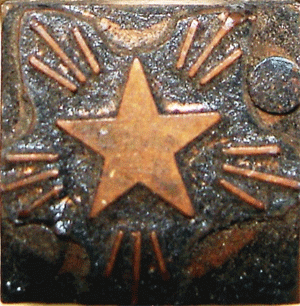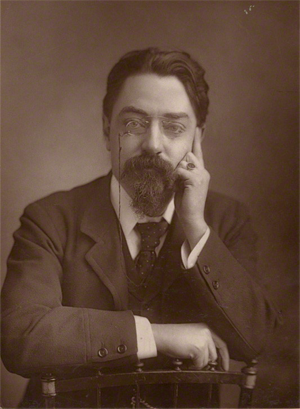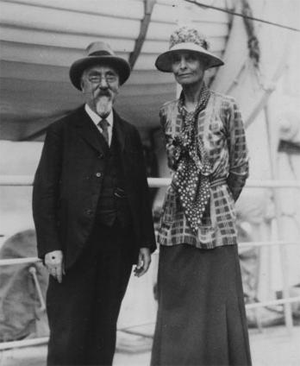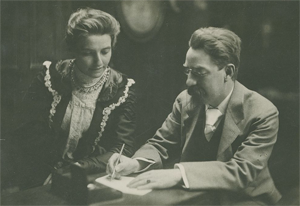Re: Annie Besant's Many Lives, by Kumari Jayawardena
Order of the Star in the East
by Wikipedia
NOTICE: THIS WORK MAY BE PROTECTED BY COPYRIGHT
The Order of the Star in the East (OSE) was an organization established by the leadership of the Theosophical Society at Adyar, India, from 1911 to 1927. Its mission was to prepare the world for the expected arrival of the World Teacher or Maitreya. The precursor of the OSE was the Order of the Rising Sun (1910-1911) and the successor was the Order of the Star (1927-1929). The founding, as well as the disbanding of the Order in 1929, led to crises in the Theosophical Society.
History
Prehistory
One of the founders of modern-era Theosophy and of the Theosophical Society, Helena Blavatsky, wrote about its future in the Key to Theosophy:
Following the original publication of the book in 1889, and based on this passage, many Theosophists anticipated the advent of Maitreya.[2] Blavatsky had also founded, and led, the so-called Esoteric Section of the Society, whose main purpose was to inform and prepare select members of the Society about the expected World Teacher. [3]
Sometime in late April or early May 1909,[4] one of the members of the Esoteric Section instructed on the World Teacher, the high-ranking Theosophist and occultist C.W. Leadbeater, encountered 14 year old Jiddu Krishnamurti on the private beach attached to the headquarters of the Theosophical Society at Adyar. At the time, Krishnamurti's father was employed by the Society, and the family lived next to the compound. Leadbeater came to believe young Krishnamurti was a suitable candidate for the "vehicle" of the supposed soon-to-reappear World Teacher, and placed him under his and the Society's wing. In late 1909, Annie Besant, then President of the Society and head of its Esoteric Section, admitted Krishnamurti into both [5] and in March 1910 she became his legal guardian. [6]
Order of the Rising Sun
Annie Besant had started commenting on the possible imminent arrival of the World Teacher in 1896, several years before her assumption of the Society's presidency in 1907. By 1909 the "coming" Teacher was a main topic of her lectures and writings.[7][8] In late 1910 the Order of the Rising Sun was founded by prominent theosophist George Arundale (the official founding date was in January 1911). The organization was generally focused on the expected World Teacher, yet the newly "discovered" Krishnamurti was - somewhat obliquely - at the center of its attention. [2]
Order of the Star in the East
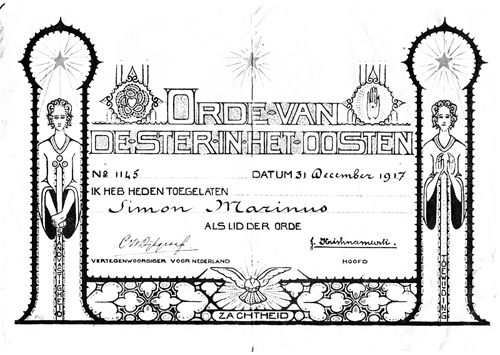
Membership Card of the Order of the Star in the East (Dutch Section).
In April 1911 Besant founded the Order of the Star in the East (OSE), which replaced the Order of the Rising Sun. The high offices of the organization were filled: "Mrs Besant and Leadbeater were made Protectors of the new Order of which Krishna" [Jiddu Krishnamurti] "was the Head, Arundale Private Secretary to the Head, and Wodehouse Organizing Secretary". [9] [10]
In December 1911 during a ceremony officiated by Krishnamurti at the close of the annual Theosophical Convention, those present were reported to be suddenly overwhelmed by a strange feeling of "tremendous power" that seemed to be flowing through Krishnamurti. In Leadbeater's description, "it reminded one irresistibly of the rushing, mighty wind, and the outpouring of the Holy Ghost at Pentecost. The tension was enormous, and every one in the room was most powerfully affected." The next day, at a meeting of the Esoteric Section, Annie Besant for the first time announced that it was now obvious Krishnamurti was indeed the chosen "vehicle". [11]
In 1912 Krishnamurti's father sued Annie Besant in order to annul her guardianship of Krishnamurti, which he had previously granted. Among other reasons stated in his deposition was his objection to the "deification" of Krishnamurti caused by Besant's "announcement that he was to be the Lord Christ, with the result that a number of respectable persons had prostrated before him." Besant eventually won the case on appeal. [12]
Because the German Section, under the General Secretaryship of Dr. Steiner, opposed the pushing of the Order of the Star in the East within the Theosophical Society in Germany, Mrs. Besant, as President of the Theosophical Society, in March, 1913, dischartered and expelled from the Theosophical Society the whole of that Section with all its Branches and over two thousand members, cancelling the diplomas of all these. [14] Most of the German Section left with Dr. Steiner and the Antroposophical Society was formed.
In 1913 some members of the OSE had to leave the Central Hindu College (CHC) in Varanasi, because the activities of the Order were deemed "unacademical". [14]
The goal of the Order was to remove the mechanical, material obstacles and difficulties from the path of the World Teacher. Most of the members were also members of the Theosophical Society; [2] however, membership was open to anyone, the only precondition being acceptance of the Order's Six Principles.
The Six Principles
The six principles of the Order of the Star in the East were: [15]
• 1. We believe that a great Teacher will soon appear in the world, and we wish so to live now that we may be worthy to know Him when He comes.
• 2. We shall try, therefore, to keep Him in our minds always, and to do in His name, and therefore to the best of our ability, all the work which comes to us in our daily occupations.
• 3. As far as our ordinary duties allow, we shall endeavour to devote a portion of our time each day to some definite work which may help to prepare for His coming.
• 4. We shall seek to make Devotion, Steadfastness and Gentleness prominent characteristics of our daily life.
• 5. We shall try to begin and end each day with a short period devoted to the asking of His blessing upon all that we try to do for Him and in His name.
• 6. We regard it as our special duty to try to recognise and reverence greatness in whomsoever shown, and to strive to co-operate, as far as we can, with those whom we feel to be spiritually our superiors.
During the existence of the OSE, Krishnamurti held many discourses and lectures in several countries, and had a large following among the membership of the Theosophical Society. National Sections of the Order were organized in many countries, with official bulletins eventually appearing in twenty-one of them, in fourteen different languages. [16] [2]
Order of the Star
In June 1927 the name of the organization was changed to Order of the Star, headquartered in Ommen, the Netherlands. In ongoing developments, Besant had proclaimed in January 1927 that "the World Teacher is here", [17] and many members expected Krishnamurti's unequivocal public proclamation of his messianic status. The renamed order had two objectives: [18]
• 1. To draw together all those who believe in the Presence of the World Teacher in the world.
• 2. To work with Him for the establishment of His ideas.
However, Krishnamurti's emphasis, in public talks and private discussions, had changed, and he talked less about the expected World Teacher. This shift in emphasis mirrored fundamental changes in Krishnamurti as a person, including his gradual disenchantment with the "World Teacher Project", which led to a complete reevaluation of his continuing association with it. [19] Finally, he disbanded the Order in Ommen on 3 August 1929, in front of about 3000 members [20] [21] and Besant herself. The Order had about 60000 members at the time. In his speech dissolving the organization, Krishnamurti said:
Krishnamurti denounced the concept of saviors, leaders and spiritual teachers, and soon after the dissolution severed his ties to Theosophy and the Theosophical Society. [23] He returned to donors estates, property, and funds that had been gifted to the Order in its various incarnations, [24] and spent the rest of his life pursuing an independent course, becoming widely known as an original, influential thinker and speaker on philosophical and religious subjects.
Consequences
In 1907 - the first year for which reliable records were kept [25] -- the worldwide membership of the Theosophical Society was estimated at over 15000; membership peaked in 1928 at about 45000. [26] Many members of the OSE were also members of the Theosophical Society; [27] consequently, as many as a third of the members of the Theosophical Society left "within a few years" of Krishnamurti's disbanding of the Order. [28] [2]
Notes
1. Blavatsky, H. P. (1889). The Key to Theosophy. London: The Theosophical Publishing Company. pp. 306-307. Italics in quoted text appear in original.
2. Schuller, Govert W. (1997). "Krishnamurti and the World Teacher Project". Theosophical History: Occasional Papers 5. (Fullerton, California: Theosophical History Foundation). ISSN 1068-2597. Alpheus. 2001. Retrieved 2010-04-12.
3. Blavatsky, H. P. (August 1931). "The Esoteric Section of the Theosophical Society: Preliminary Memorandum, 1888". The Theosophist 52: 594-595. (Adyar: Theosophical Publishing House). ISSN 0040-5892.
4. Lutyens, Mary (1975). Krishnamurti: The Years of Awakening. Farrar Straus and Giroux. pp. 20-21. ISBN 0374182221.
5. Lutyens p. 30.
6. Lutyens p. 40.
7. Lutyens pp. 11-12, 46.
8. "Christ Will Soon Visit Earth Again. Head of Theosophical Society Declares His Spirit Will Manifest Itself." Associated Press (New York City). New York: 3 August 1909. Newswire report on Besant's lecture tour in the United States.
9. Lutyens p. 46. A.E. Wodehouse, an educator and brother of the poet and writer P.G. Wodehouse, was another prominent Theosophist.
10. News regarding Krishnamurti and the Order received wide coverage: "New Religion is Headed by Youth". Grand Forks Herald (Grand Forks, North Dakota). 2 April 1912. p. 1. OCLC 12165939. "A stipling of fifteen, Krishnamurti, a Hindu is thought by many Theosophists to be a second Messiah and a new sect has been formed for his support with the star of the east the emblem."
11. Lutyens pp. 54-55. According to Leadbeater and other Theosophists, Krishnamurti had already previously passed a spiritual Initiation and had been "accepted" as a pupil by Theosophy's Spiritual Hierarchy. Lutyens "Chapter 4: First Initiation" and "Chapter 5: First Teaching", pp. 29-46 [cumulative].
12. Lutyens pp. 62, 64, 82, 84; "Chapter 8: The Lawsuit" pp 64-71.
13. Rudolf Steiner, at the time leader of the German Section of the Theosophical Society, rejected the claims made of Krishnamurti's messianic status. The resulting tensions between the German Section and Besant and Leadbeater was one of the reasons that led to a split in the Society and, in 1912, to Steiner forming the Anthroposophical Society; immediately following this step, Besant revoked the German Section's charter. The great majority of German members left the Theosophical Society in 1912-13 to join Steiner in the new group. Steiner, Rudolph; Buursink, Marijke; Schuwirth, Wim; Blomaard, Pim & Mees, Wijnand (1993) (in Dutch). Wegen naar Christus [Roads to Christ. (Bing Translator)]. Partially translated from German by Marijke Buursink. Zeist, Netherlands: Vrij Geestesleven. ISBN 9060385128.
14. Das, Bhagwan (Bhagavan) (1913). "The Central Hindu College and Mrs. Besant". (PDF). Parascience. Guerneville, California: The Science and Spirit Foundation. Retrieved 2010-04-12. The author, a co-founder (along with Annie Besant) of the CHC, was in opposition to the World Teacher Project and to the creation of the OSE.
15. Wodehouse, Ernest A. (1911). The Order of the Star in the East: its outer and inner work. Adyar: Theosophist Office. Pamphlet. OCLC 258767581.
16. "The Star: Its Purpose and Policy" (All issue dates). The Star [All issues, usually in back pages]. (Los Angeles: Star Publishing Trust). OCLC 10990552. Bulletin of the USA National Section of the Order.
17. Lutyens p. 241. Statement of Besant to the Associated Press.
18. "The Order of the Star" (All issue dates). The Star [All issues, usually in back pages]. (Los Angeles: Star Publishing Trust). OCLC 10990552. Bulletin of the USA National Section of the Order.
19. In sympathy with Krishnamurti, in 1928 Besant closed the Esoteric Section. She reopened it after the dissolution of the Order. Lutyens pp. 265-266, 276.
20. "Editorial Policy". International Star Bulletin 2 [Volume not numbered in original] (2) [Issues renumbered starting August 1929]: 4. September 1929. (Eerde: Star Publishing Trust). OCLC 34693176. From the previously official bulletin of the Order of the Star. The bulletin published several issues post-dissolution, following Krishnamurti's new direction.
21. "Cult Is Dissolved By Krishnamurti; Surprises Devotees by Asserting Organization Is Not Necessary". The Washington Post. p. M21. 4 August 1929. Associated Press (New York City). [Dateline Ommen, 3 August 1929]. ISSN 0190-8286.
22. Jiddu, Krishnamurti (September 1929). "The Dissolution of the Order of the Star: A Statement by J. Krishnamurti". International Star Bulletin 2 [Volume not numbered in original] (2) [Issues renumbered starting August 1929]: 28-34. (Eerde: Star Publishing Trust). OCLC 34693176. J.Krishnamurti Online. Retrieved 2010-04-12.
23. Lutyens pp. 276, 285.
24. Lutyens p. 276.
25. Tillet, Gregory John (1987). "Appendix 4: Membership of the Theosophical Society: Statistical Summary". Charles Webster Leadbeater 1854-1934: A Biographical Study. Volume III: Appendices, Notes and Bibliographies. [Thesis (Ph. D.)]. Department of Religious Studies. University of Sydney. pp. 942-950. OCLC 271774444. (Context from p. 943n[2]). URI http://hdl.handle.net/2123/1623. [Filename: "10Append&NotesTillett.pdf"]. Sydney escholarship. 2007. Retrieved 2010-07-16.
26. Taylor, Anne (1992). Annie Besant: A Biography. Oxford: Oxford University Press. p. 328. ISBN 0192117963.
27. Roe, Jill (1986). Beyond Belief: Theosophy in Australia 1879-1939. Sydney: University of New South Wales Press. p. 288. ISBN 0868400424.
28. Campbell, Bruce F. (1980). History of the Theosophical Movement. Berkeley, California: University of California Press. Hardcover. p. 130. ISBN 0-520-03968-8.
by Wikipedia
NOTICE: THIS WORK MAY BE PROTECTED BY COPYRIGHT
YOU ARE REQUIRED TO READ THE COPYRIGHT NOTICE AT THIS LINK BEFORE YOU READ THE FOLLOWING WORK, THAT IS AVAILABLE SOLELY FOR PRIVATE STUDY, SCHOLARSHIP OR RESEARCH PURSUANT TO 17 U.S.C. SECTION 107 AND 108. IN THE EVENT THAT THE LIBRARY DETERMINES THAT UNLAWFUL COPYING OF THIS WORK HAS OCCURRED, THE LIBRARY HAS THE RIGHT TO BLOCK THE I.P. ADDRESS AT WHICH THE UNLAWFUL COPYING APPEARED TO HAVE OCCURRED. THANK YOU FOR RESPECTING THE RIGHTS OF COPYRIGHT OWNERS.
The Order of the Star in the East (OSE) was an organization established by the leadership of the Theosophical Society at Adyar, India, from 1911 to 1927. Its mission was to prepare the world for the expected arrival of the World Teacher or Maitreya. The precursor of the OSE was the Order of the Rising Sun (1910-1911) and the successor was the Order of the Star (1927-1929). The founding, as well as the disbanding of the Order in 1929, led to crises in the Theosophical Society.
History
Prehistory
One of the founders of modern-era Theosophy and of the Theosophical Society, Helena Blavatsky, wrote about its future in the Key to Theosophy:
"Not only so, but besides a large and accessible literature ready to men's hands, the next impulse will find a numerous and united body of people ready to welcome the new torch-bearer of Truth. He will find the minds of men prepared for his message, a language ready for him in which to clothe the new truths he brings, an organization awaiting his arrival, which will remove the merely mechanical, material obstacles and difficulties from his path. Think how much one, to whom such an opportunity is given, could accomplish. Measure it by comparison with what the Theosophical Society actually has achieved in the last fourteen years, without any of these advantages and surrounded by hosts of hindrances which would not hamper the new leader." [1]
Following the original publication of the book in 1889, and based on this passage, many Theosophists anticipated the advent of Maitreya.[2] Blavatsky had also founded, and led, the so-called Esoteric Section of the Society, whose main purpose was to inform and prepare select members of the Society about the expected World Teacher. [3]
Sometime in late April or early May 1909,[4] one of the members of the Esoteric Section instructed on the World Teacher, the high-ranking Theosophist and occultist C.W. Leadbeater, encountered 14 year old Jiddu Krishnamurti on the private beach attached to the headquarters of the Theosophical Society at Adyar. At the time, Krishnamurti's father was employed by the Society, and the family lived next to the compound. Leadbeater came to believe young Krishnamurti was a suitable candidate for the "vehicle" of the supposed soon-to-reappear World Teacher, and placed him under his and the Society's wing. In late 1909, Annie Besant, then President of the Society and head of its Esoteric Section, admitted Krishnamurti into both [5] and in March 1910 she became his legal guardian. [6]
Order of the Rising Sun
Annie Besant had started commenting on the possible imminent arrival of the World Teacher in 1896, several years before her assumption of the Society's presidency in 1907. By 1909 the "coming" Teacher was a main topic of her lectures and writings.[7][8] In late 1910 the Order of the Rising Sun was founded by prominent theosophist George Arundale (the official founding date was in January 1911). The organization was generally focused on the expected World Teacher, yet the newly "discovered" Krishnamurti was - somewhat obliquely - at the center of its attention. [2]
Order of the Star in the East

Membership Card of the Order of the Star in the East (Dutch Section).
In April 1911 Besant founded the Order of the Star in the East (OSE), which replaced the Order of the Rising Sun. The high offices of the organization were filled: "Mrs Besant and Leadbeater were made Protectors of the new Order of which Krishna" [Jiddu Krishnamurti] "was the Head, Arundale Private Secretary to the Head, and Wodehouse Organizing Secretary". [9] [10]
In December 1911 during a ceremony officiated by Krishnamurti at the close of the annual Theosophical Convention, those present were reported to be suddenly overwhelmed by a strange feeling of "tremendous power" that seemed to be flowing through Krishnamurti. In Leadbeater's description, "it reminded one irresistibly of the rushing, mighty wind, and the outpouring of the Holy Ghost at Pentecost. The tension was enormous, and every one in the room was most powerfully affected." The next day, at a meeting of the Esoteric Section, Annie Besant for the first time announced that it was now obvious Krishnamurti was indeed the chosen "vehicle". [11]
In 1912 Krishnamurti's father sued Annie Besant in order to annul her guardianship of Krishnamurti, which he had previously granted. Among other reasons stated in his deposition was his objection to the "deification" of Krishnamurti caused by Besant's "announcement that he was to be the Lord Christ, with the result that a number of respectable persons had prostrated before him." Besant eventually won the case on appeal. [12]
Because the German Section, under the General Secretaryship of Dr. Steiner, opposed the pushing of the Order of the Star in the East within the Theosophical Society in Germany, Mrs. Besant, as President of the Theosophical Society, in March, 1913, dischartered and expelled from the Theosophical Society the whole of that Section with all its Branches and over two thousand members, cancelling the diplomas of all these. [14] Most of the German Section left with Dr. Steiner and the Antroposophical Society was formed.
In 1913 some members of the OSE had to leave the Central Hindu College (CHC) in Varanasi, because the activities of the Order were deemed "unacademical". [14]
The goal of the Order was to remove the mechanical, material obstacles and difficulties from the path of the World Teacher. Most of the members were also members of the Theosophical Society; [2] however, membership was open to anyone, the only precondition being acceptance of the Order's Six Principles.
The Six Principles
The six principles of the Order of the Star in the East were: [15]
• 1. We believe that a great Teacher will soon appear in the world, and we wish so to live now that we may be worthy to know Him when He comes.
• 2. We shall try, therefore, to keep Him in our minds always, and to do in His name, and therefore to the best of our ability, all the work which comes to us in our daily occupations.
• 3. As far as our ordinary duties allow, we shall endeavour to devote a portion of our time each day to some definite work which may help to prepare for His coming.
• 4. We shall seek to make Devotion, Steadfastness and Gentleness prominent characteristics of our daily life.
• 5. We shall try to begin and end each day with a short period devoted to the asking of His blessing upon all that we try to do for Him and in His name.
• 6. We regard it as our special duty to try to recognise and reverence greatness in whomsoever shown, and to strive to co-operate, as far as we can, with those whom we feel to be spiritually our superiors.
During the existence of the OSE, Krishnamurti held many discourses and lectures in several countries, and had a large following among the membership of the Theosophical Society. National Sections of the Order were organized in many countries, with official bulletins eventually appearing in twenty-one of them, in fourteen different languages. [16] [2]
Order of the Star
In June 1927 the name of the organization was changed to Order of the Star, headquartered in Ommen, the Netherlands. In ongoing developments, Besant had proclaimed in January 1927 that "the World Teacher is here", [17] and many members expected Krishnamurti's unequivocal public proclamation of his messianic status. The renamed order had two objectives: [18]
• 1. To draw together all those who believe in the Presence of the World Teacher in the world.
• 2. To work with Him for the establishment of His ideas.
However, Krishnamurti's emphasis, in public talks and private discussions, had changed, and he talked less about the expected World Teacher. This shift in emphasis mirrored fundamental changes in Krishnamurti as a person, including his gradual disenchantment with the "World Teacher Project", which led to a complete reevaluation of his continuing association with it. [19] Finally, he disbanded the Order in Ommen on 3 August 1929, in front of about 3000 members [20] [21] and Besant herself. The Order had about 60000 members at the time. In his speech dissolving the organization, Krishnamurti said:
"I maintain that Truth is a pathless land, and you cannot approach it by any path whatsoever, by any religion, by any sect. That is my point of view, and I adhere to that absolutely and unconditionally. Truth, being limitless, unconditioned, unapproachable by any path whatsoever, cannot be organized; nor should any organization be formed to lead or to coerce people along any particular path." [22]
Krishnamurti denounced the concept of saviors, leaders and spiritual teachers, and soon after the dissolution severed his ties to Theosophy and the Theosophical Society. [23] He returned to donors estates, property, and funds that had been gifted to the Order in its various incarnations, [24] and spent the rest of his life pursuing an independent course, becoming widely known as an original, influential thinker and speaker on philosophical and religious subjects.
Consequences
In 1907 - the first year for which reliable records were kept [25] -- the worldwide membership of the Theosophical Society was estimated at over 15000; membership peaked in 1928 at about 45000. [26] Many members of the OSE were also members of the Theosophical Society; [27] consequently, as many as a third of the members of the Theosophical Society left "within a few years" of Krishnamurti's disbanding of the Order. [28] [2]
Notes
1. Blavatsky, H. P. (1889). The Key to Theosophy. London: The Theosophical Publishing Company. pp. 306-307. Italics in quoted text appear in original.
2. Schuller, Govert W. (1997). "Krishnamurti and the World Teacher Project". Theosophical History: Occasional Papers 5. (Fullerton, California: Theosophical History Foundation). ISSN 1068-2597. Alpheus. 2001. Retrieved 2010-04-12.
3. Blavatsky, H. P. (August 1931). "The Esoteric Section of the Theosophical Society: Preliminary Memorandum, 1888". The Theosophist 52: 594-595. (Adyar: Theosophical Publishing House). ISSN 0040-5892.
4. Lutyens, Mary (1975). Krishnamurti: The Years of Awakening. Farrar Straus and Giroux. pp. 20-21. ISBN 0374182221.
5. Lutyens p. 30.
6. Lutyens p. 40.
7. Lutyens pp. 11-12, 46.
8. "Christ Will Soon Visit Earth Again. Head of Theosophical Society Declares His Spirit Will Manifest Itself." Associated Press (New York City). New York: 3 August 1909. Newswire report on Besant's lecture tour in the United States.
9. Lutyens p. 46. A.E. Wodehouse, an educator and brother of the poet and writer P.G. Wodehouse, was another prominent Theosophist.
10. News regarding Krishnamurti and the Order received wide coverage: "New Religion is Headed by Youth". Grand Forks Herald (Grand Forks, North Dakota). 2 April 1912. p. 1. OCLC 12165939. "A stipling of fifteen, Krishnamurti, a Hindu is thought by many Theosophists to be a second Messiah and a new sect has been formed for his support with the star of the east the emblem."
11. Lutyens pp. 54-55. According to Leadbeater and other Theosophists, Krishnamurti had already previously passed a spiritual Initiation and had been "accepted" as a pupil by Theosophy's Spiritual Hierarchy. Lutyens "Chapter 4: First Initiation" and "Chapter 5: First Teaching", pp. 29-46 [cumulative].
12. Lutyens pp. 62, 64, 82, 84; "Chapter 8: The Lawsuit" pp 64-71.
13. Rudolf Steiner, at the time leader of the German Section of the Theosophical Society, rejected the claims made of Krishnamurti's messianic status. The resulting tensions between the German Section and Besant and Leadbeater was one of the reasons that led to a split in the Society and, in 1912, to Steiner forming the Anthroposophical Society; immediately following this step, Besant revoked the German Section's charter. The great majority of German members left the Theosophical Society in 1912-13 to join Steiner in the new group. Steiner, Rudolph; Buursink, Marijke; Schuwirth, Wim; Blomaard, Pim & Mees, Wijnand (1993) (in Dutch). Wegen naar Christus [Roads to Christ. (Bing Translator)]. Partially translated from German by Marijke Buursink. Zeist, Netherlands: Vrij Geestesleven. ISBN 9060385128.
14. Das, Bhagwan (Bhagavan) (1913). "The Central Hindu College and Mrs. Besant". (PDF). Parascience. Guerneville, California: The Science and Spirit Foundation. Retrieved 2010-04-12. The author, a co-founder (along with Annie Besant) of the CHC, was in opposition to the World Teacher Project and to the creation of the OSE.
15. Wodehouse, Ernest A. (1911). The Order of the Star in the East: its outer and inner work. Adyar: Theosophist Office. Pamphlet. OCLC 258767581.
16. "The Star: Its Purpose and Policy" (All issue dates). The Star [All issues, usually in back pages]. (Los Angeles: Star Publishing Trust). OCLC 10990552. Bulletin of the USA National Section of the Order.
17. Lutyens p. 241. Statement of Besant to the Associated Press.
18. "The Order of the Star" (All issue dates). The Star [All issues, usually in back pages]. (Los Angeles: Star Publishing Trust). OCLC 10990552. Bulletin of the USA National Section of the Order.
19. In sympathy with Krishnamurti, in 1928 Besant closed the Esoteric Section. She reopened it after the dissolution of the Order. Lutyens pp. 265-266, 276.
20. "Editorial Policy". International Star Bulletin 2 [Volume not numbered in original] (2) [Issues renumbered starting August 1929]: 4. September 1929. (Eerde: Star Publishing Trust). OCLC 34693176. From the previously official bulletin of the Order of the Star. The bulletin published several issues post-dissolution, following Krishnamurti's new direction.
21. "Cult Is Dissolved By Krishnamurti; Surprises Devotees by Asserting Organization Is Not Necessary". The Washington Post. p. M21. 4 August 1929. Associated Press (New York City). [Dateline Ommen, 3 August 1929]. ISSN 0190-8286.
22. Jiddu, Krishnamurti (September 1929). "The Dissolution of the Order of the Star: A Statement by J. Krishnamurti". International Star Bulletin 2 [Volume not numbered in original] (2) [Issues renumbered starting August 1929]: 28-34. (Eerde: Star Publishing Trust). OCLC 34693176. J.Krishnamurti Online. Retrieved 2010-04-12.
23. Lutyens pp. 276, 285.
24. Lutyens p. 276.
25. Tillet, Gregory John (1987). "Appendix 4: Membership of the Theosophical Society: Statistical Summary". Charles Webster Leadbeater 1854-1934: A Biographical Study. Volume III: Appendices, Notes and Bibliographies. [Thesis (Ph. D.)]. Department of Religious Studies. University of Sydney. pp. 942-950. OCLC 271774444. (Context from p. 943n[2]). URI http://hdl.handle.net/2123/1623. [Filename: "10Append&NotesTillett.pdf"]. Sydney escholarship. 2007. Retrieved 2010-07-16.
26. Taylor, Anne (1992). Annie Besant: A Biography. Oxford: Oxford University Press. p. 328. ISBN 0192117963.
27. Roe, Jill (1986). Beyond Belief: Theosophy in Australia 1879-1939. Sydney: University of New South Wales Press. p. 288. ISBN 0868400424.
28. Campbell, Bruce F. (1980). History of the Theosophical Movement. Berkeley, California: University of California Press. Hardcover. p. 130. ISBN 0-520-03968-8.
